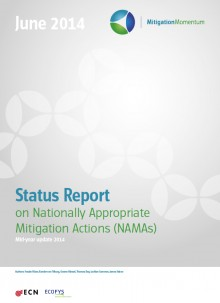NAMAs
Introduction to NAMAs
Nationally Appropriate Mitigation Actions (NAMAs) are policies, programmes and projects that developing countries undertake to contribute to the global effort to reduce greenhouse gas emissions.
Paragraph 1 (b) (ii) of the Bali Action Plan called for “Nationally appropriate mitigation actions’ (NAMAs) by developing country Parties in the context of sustainable development, supported and enabled by technology, financing and capacity building, in a measurable, reportable and verifiable manner". [1] In Copenhagen in 2009, 114 countries agreed to the Copenhagen Accord and committed to undertaking mitigation actions as part of a shared responsibility to reduce greenhouse gas emissions, including an agreement that support should be provided to developing countries. In Cancun in 2010, developed countries agreed to provide $30 billion in fast-start financing and mobilise $100 billion per year by 2020 to finance mitigation and adaptation in developing countries.
Developed countries have committed to supporting meaningful mitigation actions in developing countries through financing, technology transfer and capacity building. The policy framework around NAMAs is still being developed but NAMAs are set to become a building block for a future climate agreement.
In the 17th Conference of Parties in Durban, South Africa, two major pieces of the puzzle emerged that were needed to move forward on NAMAs. The Green Climate Fund (GCF) was launched after Parties agreed on the governing instrument which lays out its design. The Fund will act as the operating entity for the financial mechanism of the Convention, helping channel funds to developing countries to reduce their greenhouse gas emissions and adapt to the negative impacts of climate change. While the structure is currently being set, major work will still have to be undertaken to raise the large amount of funds needed to undertake substantial mitigation actions.
Another important decision taken in Durban is the establishment of the NAMA registry as a dynamic web-based platform managed by the UNFCCC secretariat where countries can voluntarily submit information on nationally appropriate mitigation actions seeking international support, to facilitate the matching of financial, technological and capacity-building support for these actions and to track and recognize the NAMAs being undertaken. [2]The UNFCCC launched the prototype of the registry in 2012, several countries have submitted NAMAs searching support for preparation or implementation or for recognition of unilateral NAMAs. These pieces of the puzzle, along with a renewed commitment by developed countries to deploy financial resources will support developing countries in implementing mitigation and adaptation actions.
Some countries have announced their intention to fund NAMAs. At COP 18 in Doha, Qatar, the UK and Germany announced the establishment of the “NAMA Facility” to facilitate financial flows for NAMAs, covering a total of €70 million. [3]
For see more detailed information about NAMAs, please see the NAMA literature page.
References
- ↑ COP13, "Decision [-/CP.13] Bali Action Plan" (December 2007).
- ↑ COP17, "Draft decision [-/CP.17] Outcome of the work of the Ad Hoc Working Group on Long-term Cooperative Action under the Convention" (December 2011).
- ↑ Federal Ministry for Environment, Nature Conversation and Nuclear Safety, Department of Energy & Climate Change, "Background information: NAMA Facility" (December 2012), available at http://www.bmu.de/fileadmin/bmu-import/files/pdfs/allgemein/application/pdf/factsheets_nama_en_bf.pdf.
